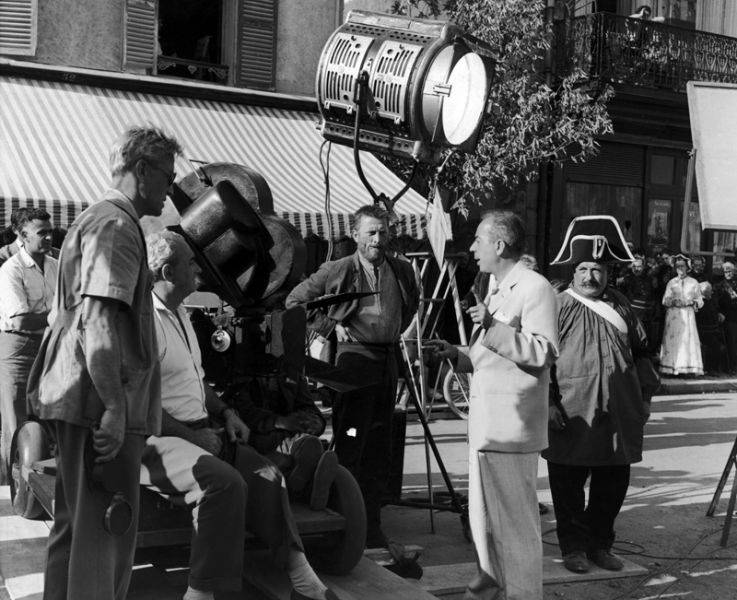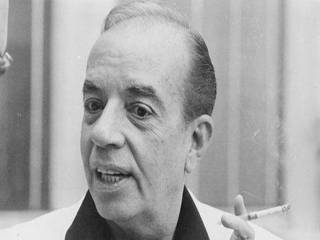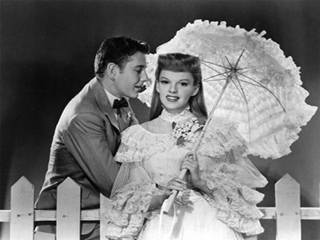BAMcinématek Presents The Complete Vincente Minnelli
Beginning tonight (and continuing through November 2), BAMcinématek presents The Complete Vincente Minnelli, the first full New York retrospective of the Hollywood master in more than two decades.
This 35-film series pays homage to one of the all-time great Hollywood directors, with a career that included successful forays into the musical (which earned him his reputation at MGM), subversive and deeply personal melodramas and sensitive biopics, and airy comedies. The retrospective, presented in conjunction with the Locarno International Film Festival, offers a chance to reevaluate the Hollywood giant’s status as an auteur, truly one of cinema’s greatest artists.
Popularly associated with meticulously decorated, nostalgic musicals like Meet Me in St. Louis (1944), An American in Paris (1951), The Band Wagon (1953), and the beloved Gigi (which swept the 1959 Oscars, winning in all nine categories that it was nominated including Best Picture and Best Director), Minnelli also proved to be a master of multiple genres over his 34-year directing career, including several darker dramas that were under-appreciated by his contemporaries. Minnelli was as poetically cynical as Billy Wilder in the Kirk Douglas and Lana Turner vehicle The Bad and the Beautiful (1952) and its follow-up, Two Weeks in Another Town (1960). He was as skilled as Douglas Sirk at the Technicolor CinemaScope melodrama in The Cobweb (1955) and Home From the Hill (1960). Presenting his entire corpus at once offers a chance to appreciate his fabulous range, while also calling attention to the themes, motifs, and pet obsessions that unify his films.
Lester Anthony Minnelli (1903–1986) was born in Chicago to vaudevillian showfolk: his parents (Marie and Vincent) operated the Minnelli Brothers Tent Theater and often had their son participate as an actor.
His paternal grandfather, Vincenzo Minnelli and great-uncle Domenico Minnelli, both Sicilian revolutionaries, were forced to leave Sicily after the collapse of the provisional Sicilian government that arose from the 1848 revolution against Ferdinand II and Bourbon rule. Domenico Minnelli had been Vice-Chancellor of the Gran Corte Civile in Palermo at the time he helped organize the January 12, 1848 uprising there. After the Bourbon return to power Vincenzo reportedly hid in the catacombs of Palermo for 18 months before being successfully smuggled onto a New York-bound fruit steamer.While traveling as a piano demonstrator for Knabe Pianos, Vincenzo met his future wife Nina Picket during a stop in Delaware, Ohio.
The thrill of escapism stuck, and while the young Minnelli bounced between Chicago and Ohio, he dreamed of living and working in show business. After a stint decorating shop windows at Chicago’s Marshall Field’s—a telling start which clever critics of his techniques of artifice would perennially note thereafter—he found his way to New York and began designing costumes and sets for Broadway productions and Radio City Music Hall spectaculars. He eventually left Radio City to direct his own productions, including lauded runs of The Ziegfeld Follies of 1936 (which he would later adapt for the screen) and The Show is On. Among those who took notice of the soft-spoken Midwesterner’s immense talent for theatrical pomp was lyricist and Hollywood producer Arthur Freed, Minnelli’s longtime champion. Freed offered Minnelli a job at MGM, where he would enjoy one of Hollywood’s greatest (and longest) studio-director relationships, with over 30 films.
Opening The Complete Vincente Minnelli tonight is Cabin in the Sky (1943), Minnelli’s first job as director and first musical. It features one of the highest concentrations of homegrown American talent ever assembled in one film; Pauline Kael called it “One of the best musicals ever made.” With singing legend Ethel Waters as the patient wife to Eddie “Rochester” Anderson’s rascally Little Joe, the film travels from waking to dream and heaven to hell, featuring Lena Horne, Louis Armstrong, Duke Ellington, and Rex Ingram as “The Devil.” The forward-thinking use of an all-black cast meant Cabin in the Sky went unseen in many cities at the time, but the great cast and fantastic songs has made it last it as great entertainment for decades since.
Just one year later came Meet Me in St. Louis (screening on Sat, Oct 1), a riot of meticulous
Technicolor, impossibly intricate set decoration, and Judy Garland’s classic renditions of “The Trolley Song,” “Have Yourself a Merry Little Christmas,” and the ebullient title tune. The film is Minnelli’s tribute to home, but the nostalgia is laced with wisdom and even horror, as in the incredible Halloween scene in which the director’s fluid camera tracks a young Margaret O’Brien down the street after a successful prank. This sort of bracing, standout capital-s Scene would become de rigueur for Minnelli, as would working with Garland, who later became his wife and collaborator for the New York-set romance The Clock (1945—Sep 29), with Robert Walker, and the Technicolor Caribbean musical , The Pirate (1948—Oct 16), with songs by Cole Porter.
Minnelli would return to the musical often and at such a high level of artistry that there is no consensusn among critics and fans about which is the best. Dave Kehr called The Band Wagon (Sep 30) “the height of the American musical... Rife with great numbers,” and Pauline Kael enthused: “There have been few screen musicals as good as this one.” It is hard to top Fred Astaire and Cyd Charisse dancing and serenading each other in Central Park to Arthur Schwartz and Howard Dietz’s “Dancing in the Dark”. And yet the same film features Astaire, Nanette Fabray, and Jack Buchanan in baby bodies performing the hilariously angry and utterly surreal “Triplets.” Best Picture Oscar winner An American in Paris (Oct 8) is full of rapturous George Gershwin songs and the masterful dancing of Gene Kelly and limber Leslie Caron, and climaxes with a famous 16-minute dance sequence set to the title tune.
Upon its release Time raved: “A grand show—a brilliant combination of Hollywood’s opulence and technical wizardry with the kind of taste and creativeness that most high-budgeted musicals notoriously lack.”
Minnelli collaborated again with Kelly on Brigadoon (1954), “a classic—if not the classic—
Minnelli musical” (Phil Hardy, Time Out London), which closes the retrospective on November 2. In this exercise in reality abandonment, the hero slips into a fantastical dream world (here, a mythical Scottish village) to the music of Lerner & Loewe. Minnelli brought all of his skill as a director of comedy to 1960’s Bells are Ringing (Oct 29), in which Judy Holliday plays an operator for “Susanswerphone” who becomes too involved in the lives of her clients, especially Dean Martin’s writer’s-blocked playwright.
In the director’s final musical, On a Clear Day You Can See Forever (1970—Oct 24), he tells the story of Barbra Streisand’s Daisy Gamble, who, while under hypnosis (as in The Pirate), reveals her past life as a 19th-century British flirt. “Minnelli’s love of décor transforms the movie into very real fantasy... [He] handles [Streisand] gingerly but with an appreciation of her beauty and of the largely unrealized possibilities of her talent. Talent such as hers will not break when tested; it becomes enriched” (Vincent Canby, The New York Times).
It might come as a surprise to viewers relatively new to Minnelli that he was in every way as much a master of the melodrama as a master of the musical. In his excellent 1949 adaptation of Madame Bovary (Oct 7), he zeroes in on and sympathizes with Jennifer Jones’ character’s novel-fed ambitions of romance and glamour. While not tone-deaf to Flaubert’s element of ironic mockery, Minnelli is hypersensitive to the unfairness of her pathetic condition, crystallized in the famous ball sequence as Emma, in overflowing white gown, swirls deliriously with both her chivalrous dance partner and the camera, catching the reflection of her ideal self in an ornate mirror.
Kirk Douglas proved himself as vital a collaborator as Gene Kelly in his films with Minnelli, starting with the sophisticated behind-the-scenes satire-tragedy The Bad and the Beautiful (Sep 24). Douglas, never more appropriately vigorous and alive, plays Jonathan Shields, a Sammy Glick-like producer, who brutishly, though not without caring, plows through relationships with screenwriter James (Dick Powell), director Fred (Barry Sullivan), and troubled star Georgia (Lana Turner). Shields’ movie titles actually appear on a marquee in The Band Wagon, and the self-reflexive recycling is even more explicit in the unofficial sequel Two Weeks in Another Town (Sep 25), with Douglas now playing a washed-up actor recovering with a role on a set in Rome. Presaging the modernism and moviemaking
commentary of Contempt and 8 ½, Two Weeks is “a great masterpiece, an extreme film in which personal disintegration and recovery play out against and amid the shattering of a culture of cinema” (Chris Fujiwara, Moving Image Source). In the biopic Lust for Life (1956—Oct 9), which Minnelli has suggested is the most personally meaning to him of any of his films, Douglas plays the first in a long line of memorable, cinematic Vincent van Goghs.
Perhaps the two Minnelli melodramas most ripe for full reevaluation are The Cobweb (Oct 26—part of a Cinemachat with film critic Elliott Stein) and The 4 Horsemen of the Apocalypse (1962—Nov 1). In the former, Gloria Grahame, who won an Oscar for her role as Powell’s wife in The Bad and the Beautiful, plays wife to head doctor played by Richard Widmark, who flirts with the troubled painter and clashes with Lillian Gish’s shrewish matron. The seemingly confining walls of the institution and small town are made Freudian and overwhelming by Keogh Gleason and Edwin Willis’ set design and George Folsey’s deft CinemaScope lensing. In 4 Horsemen, an ambitious remake of the silent film, everything is on a grander scale at the service of illustrating, according to Minnelli, the “senselessness of war.” With the action moved to World War II and Glenn Ford now starring as a reluctant but brave member of the French resistance, who must fight his own family members, the film is grand opera and
the score by André Previn is near-constant. Even the found footage is dreamy, as Minnelli tints and superimposes it almost beyond recognition. “To understand this film is to penetrate the whole oeuvre of a filmmaker wrongly considered to be a minor one whose talent is confined to comedies and musicals” (Jean Douchet, Cahiers du cinéma).
Even Minnelli’s “straight” laughers carry the darker tones of his melodramas. Father of the Bride (1950—Oct 11), based on then-amateur writer Edward Streeter’s personal experience, captures the Spencer Tracy character’s very real frustrations and sense of creeping mortality, particularly in an expressionistic nightmare sequence. The film, “a certifiable classic of American pop culture” (James Naremore, The Films of Vincente Minnelli), spawned a sequel a year later, Father’s Little Dividend (also Oct 11), starring Elizabeth Taylor, who would work again with Minnelli (and husband Richard Burton) 15 years later in The Sandpiper (1965—Oct 13). The Cobweb’s Lauren Bacall returned for the John Alton-shot battle-of-the-sexes comedy Designing Woman (1957—Oct 5), which won screenwriter George Wells an Oscar. In Goodbye Charlie (1964—Oct 17), a farcical flipside to The Bad and the Beautiful starring Tony Curtis and Debbie Reynolds, Minnelli raises questions about the slipperiness of identity.
Minnelli’s biography is defined by his work, all-consuming as it was. Though of course, he, with Garland, also produced daughter Liza and cast her in his final film, A Matter of Time (1976—Oct 25), which was recut by the studio but ultimately a fascinating work. Minnelli biographer Joe McElhaney will discuss this film in person at BAM following the 6:50pm screening. The Complete Vincente Minnelli is filled out by additional comedies, melodramas, and musicals (complete schedule below), which in summary offers a rather overwhelming argument for Minnelli’s mastery as not just a mere stylist, but an accomplished auteur. His work has often divided critics and spawned a conflicting mass of academics looking to diagnose Minnelli’s own issues as reflected onscreen. Finding widespread acclaim and artistic success early on, he managed to maintain it for most of his career while never abandoning his own private, occasionally idiosyncratic devotion to presenting beauty, fantasy, and the
intruding friction of the commonplace with an invariably awe-inspiring visual talent and sense of wonder.






































i-Italy
Facebook
Google+
This work may not be reproduced, in whole or in part, without prior written permission.
Questo lavoro non può essere riprodotto, in tutto o in parte, senza permesso scritto.